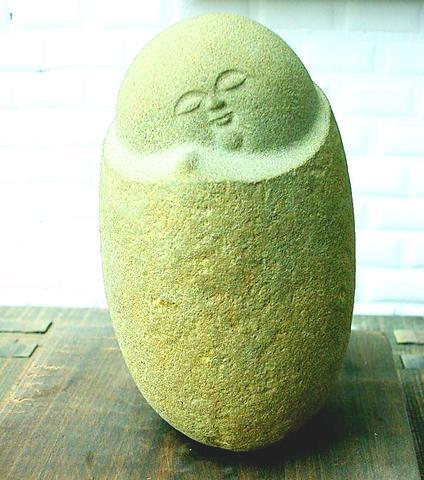The arts in Taiwan have coexisted along parallel streams, often without mutual contact. At the highest, Government-funded arts cater to the elite avant-garde who glorify university fine art departments and national or municipal museums.
Every two years in Venice, some of these Taiwanese artists meet other avant-gardists (again), exchange the latest ideas and then bring them back to their respective lands. Such contacts make the world a smaller place as images and concepts spread -- sometimes like a virus -- affecting Venice art participants and their associates at home yearning to "modernize." Their videos or installations, however, usually remain unknown to Taiwan's population at large.

PHOTO COURTESY OF FANGLIAO ARTISTS' VILLAGE
At the lowest end are the traditional "backwater" manifestations at temples and temple-markets that still exude strong regional flavors, tastes and images encountered nowhere else on earth.

In between fall high school art classes and workshops teaching people to sketch from Western plaster busts, and the vast majority of Taiwan's modern public who are too urbanized to recognize local traditions, or too lacking in art education to be interested in experiencing "modern art."
In recent years, however, there has been a healthy development in Taiwan bringing arts to people by way of artists colonies. The government has been funding imaginative reclamation projects where abandoned sugar factories in their park-like environs are transformed into open-air theaters, art galleries, warehouse-sized show-cases, conference sites and individual artists' housing complexes.
In Taiwan's southernmost Pingdong County is the little fishing village of Fangliao. Its waterways are crammed with fishing boats and nets, and its restaurants resplendent with fish and seafood freshly caught. Fangliao is celebrated for bell-shaped "Black Pearl" bell-fruit of glowing dark crimson skin, and tiny whitebait called Burahi.
Now we can say that Fangliao is celebrated also for its admirable Fangliao Artists' Village (
My visit was upon a gray day, but the sea was a bright green. Not far from the beach is the Artists' Village set along a lane with row-houses built of local dark brick. Many of these abandoned dormitories are renovated -- while keeping the original facade. Young artists and architects are invited to live and work there on an annual contract basis in the 20 two-story brick houses that function as residences.
Last year there were several avant-garde installation artists. Today there are 18 resident artists, all from Taiwan, including a woodcut printmaker, a stone sculptor, a wood sculptor, a paper sculptor, a leather carver, several oil painters, a traditional ink painter, a mosaic artist, an interior decorator, a puppet-maker and puppeteer, and a the piano and drums percussion musician.
The portly, humorous Huang Mingdao (
Huang's puppets are made of recycled bottles brightly painted. He writes the plays and goes to different districts to teach school children to make puppets, manipulate them and act out ancient local myths.
Sculptor Huang Jingyung (

Exceptions to the rule are sometimes revealing. For a brief few years, there was an emerging ideological split between the Democratic Progressive Party (DPP) and Chinese Nationalist Party (KMT) that appeared to be pushing the DPP in a direction that would be considered more liberal, and the KMT more conservative. In the previous column, “The KMT-DPP’s bureaucrat-led developmental state” (Dec. 11, page 12), we examined how Taiwan’s democratic system developed, and how both the two main parties largely accepted a similar consensus on how Taiwan should be run domestically and did not split along the left-right lines more familiar in

This month the government ordered a one-year block of Xiaohongshu (小紅書) or Rednote, a Chinese social media platform with more than 3 million users in Taiwan. The government pointed to widespread fraud activity on the platform, along with cybersecurity failures. Officials said that they had reached out to the company and asked it to change. However, they received no response. The pro-China parties, the Chinese Nationalist Party (KMT) and Taiwan People’s Party (TPP), immediately swung into action, denouncing the ban as an attack on free speech. This “free speech” claim was then echoed by the People’s Republic of China (PRC),

As I finally slid into the warm embrace of the hot, clifftop pool, it was a serene moment of reflection. The sound of the river reflected off the cave walls, the white of our camping lights reflected off the dark, shimmering surface of the water, and I reflected on how fortunate I was to be here. After all, the beautiful walk through narrow canyons that had brought us here had been inaccessible for five years — and will be again soon. The day had started at the Huisun Forest Area (惠蓀林場), at the end of Nantou County Route 80, north and east

Specialty sandwiches loaded with the contents of an entire charcuterie board, overflowing with sauces, creams and all manner of creative add-ons, is perhaps one of the biggest global food trends of this year. From London to New York, lines form down the block for mortadella, burrata, pistachio and more stuffed between slices of fresh sourdough, rye or focaccia. To try the trend in Taipei, Munchies Mafia is for sure the spot — could this be the best sandwich in town? Carlos from Spain and Sergio from Mexico opened this spot just seven months ago. The two met working in the